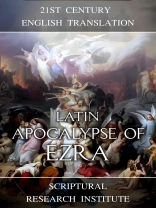In the early centuries of the Christian era, several texts called the Apocalypse of Ezra were in circulation among Jews and Christians. The original is believed to have been written in Hebrew, Aramaic, or Syriac, and is commonly known as the Judahite Apocalypse of Ezra. This version was translated into Greek sometime before 200 AD and circulated widely within the early Christian churches. This book claimed that the prophet ‘Shealtiel, who was called Ezra’ wrote 904 books, and its popularity seems to have inspired several Christian era Apocalypses of Ezra, presumably beginning with the short Latin Apocalypse of Ezra which claimed to be the ‘second book of the prophet Ezra.’ The prophet Shealtiel was not Ezra the scribe, who the books of Ezra are named after in the Septuagint and Masoretic text, but the son of former King Jehoiachin of Judah, who had been taken captive by the Babylonians in 597 BC.
The shorter Latin Apocalypse of Ezra has become fused with the Judahite Apocalypse of Ezra in most Catholic and Protestant translations, however, scholars divide the Catholic versions of 4th Esdras (Protestant 2nd Esdras) into three sections, with only the core twelve chapters that correspond to the Orthodox and Ethiopian versions of the book labeled as 4th Ezra. The opening two chapters, which are only found in the Catholic version, are labeled as 5th Ezra, while the last 2 chapters found in Catholic version, as well as fragments surviving in an ancient Greek translation, are labeled 6th Ezra. 5th Ezra and 6th Ezra appear to have originally been one document, which is commonly called the Latin Apocalypse of Ezra, although it was almost certainly not written in Latin.
In chapter 1 and 2 of the apocalypse, which is 5th Ezra, the author claimed to be Ezra the scribe, and gave his genealogy, which is found in the books of Ezra found in the Masoretic text and Septuagint, however, then claims he had been held captive in Media during the time of Artaxerxes. Chapter 3 and the beginning of chapter 4 of the apocalypse, the bulk of 6th Ezra, appears to be much older, and describe a world that the author of the longer apocalypse did not seem to understand. The prophecy itself was focused on fall of the Assyrian Empire, which did fall in 609 BC. The Assyrian Empire fell to a large alliance of its enemies, including the Medes, Scythians, and the rebelling Babylonians. The prophet, whoever it was, did not know this would happen, and did not mention the Medes or Scythians, and prophesied that after defeating the Assyrians, the conquerors would besiege Babylon, demonstrating the prophesy was made before Babylon revolted in 626 BC.







![Copertina de Brian Schrag & Julisa Rowe: Community Arts for God's Purposes [Chinese] 貼近神心意的社群藝術 Copertina de Brian Schrag & Julisa Rowe: Community Arts for God's Purposes [Chinese] 貼近神心意的社群藝術](https://static.worldofdigitals.com/thumb_webp/740/9781645083740.webp)




